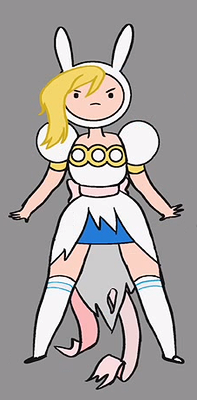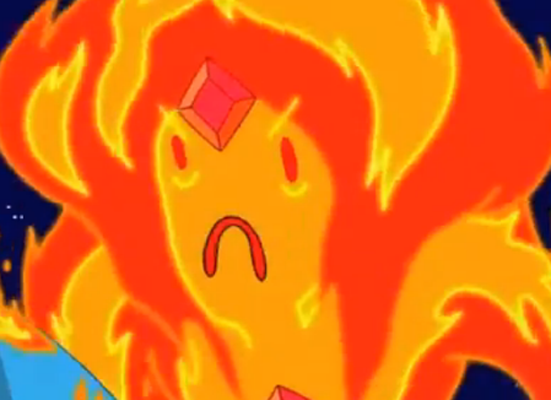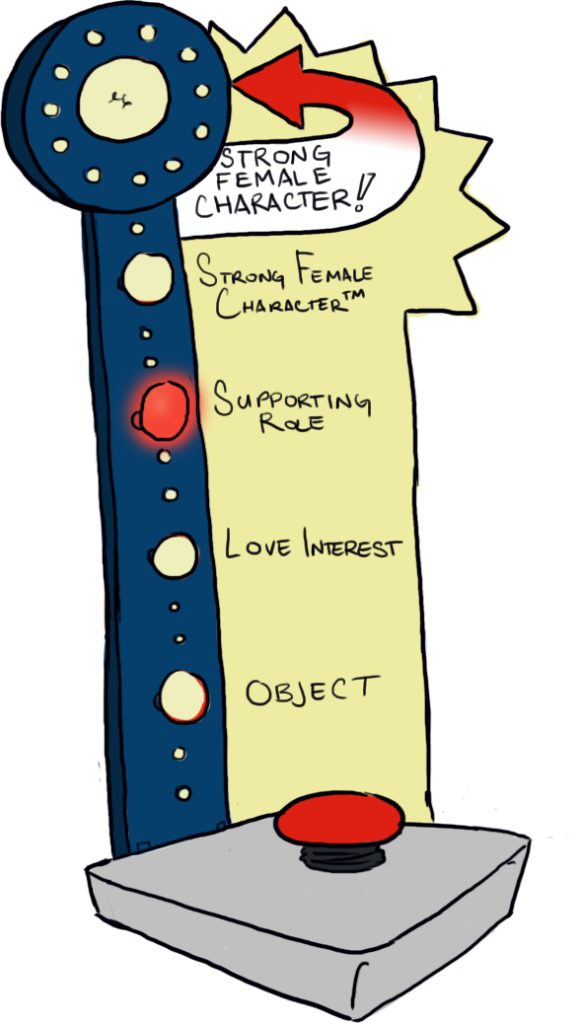In last week’s post, we talked (and talked and talked) about the subversive work that the Adventure Time crew has done with Marceline. This week, we’d like to tackle the way in which this subversive spirit has affected a few of the more minor characters.
Fionna
We start with someone who, despite her limited screen time, isn’t actually minor at all. Fionna is the gender-swapped version of the show’s hero, Finn; with the help of her cat, Cake, she must keep Ooo (and Prince Gumball) safe from the evil Ice Queen.
According to Rule 63 of the infamous Rules of the Internet, for every given male character, there is a female version of that character, and vice versa. Gender swapping is so pervasive a phenomenon that the rule’s popularity is only dwarfed by that of Rule 34: “There is porn of it. No exceptions.” However, while Rule 34 only proves what Avenue Q’s Trekkie Monster has been telling us for a decade, Rule 63 has a more complex function.
The Geena Davis Institute on Gender in Media found that, in G-rated films released between 2006 and 2009, women and girls only comprised 32.6% of the characters onscreen. This number only decreases as the rating goes up. Essentially, in mainstream Hollywood, the ratio of men to women is 2:1. Now imagine a world in which the opposite is true: women star in nearly all blockbusters, women make up the majority of background characters, and the “womance” becomes a common trope. Women play all of our admirable action heroes, all of our bold world leaders, all of our iconic villains. When a film starring a man or a group of men succeeds at the box office, it is nevertheless dismissed as a “male tale.” Gender swapping, taken to its logical conclusion, shows us just how messed up our current media norms really are.
Although the show is certainly engaging in this conversation, in its use of gender swapping, Adventure Time seems to be responding to a very specific -- and ultimately negative -- application of the trope.
Let me explain. (No, there is too much. Let me sum up.) Although she appears to be a few years older than her male counterpart, Fionna closely resembles Finn, possessing his thirst for adventure, his crush on Bubblegum (now Gumball), his friendship with Marceline (now Marshall Lee), his canine best friend (now feline), and a very near approximation of his wardrobe. However, whereas many of Finn’s personality traits are considered pretty standard for a thirteen-year-old boy, they are somewhat less common among cartoon representations of girls in their late teens and therefore take on a slightly different significance.
Fionna is labelled as a tomboy, seemingly just because she loves adventuring and finds wearing dresses to be a chore, to the extent that she wears her everyday clothes underneath the one that Cake recommends she wear. As she says, she is “all about swords” and prefers a wardrobe that accommodates their inclusion. When she is being serenaded by a false Prince Gumball, she provides the pyrotechnics by chopping through a swarm of attacking creatures. She is an accomplished hero, saving Gumball on several occasions and holding him in the very definition of a heroic pose. She is less competent when it comes to romancing or actually talking to her crush; in fact, it is only by the end of their evening together that she can confidently and excitedly state, “It was a date! There was singing and junk!”
Their next rendezvous doesn’t go so well. Gumball urges Fionna to join him in his bedroom, and she’s clearly very uncomfortable with the idea of the sudden shift in their relationship. She gets even more uncomfortable when she notices that the real Gumball is frozen to the ceiling and the prince that has been wooing her is the Ice Queen in disguise. The end of this scene is the pivotal moment of the episode, not because it clears up the plot, but because it reveals the subversive function of Fionna.
We’ve all noticed that Hollywood has a tendency to make movies starring men about universal ideas and experiences, and movies starring women about love, usually of the romantic variety. A recent television-based example is a much-criticized aspect of The Legend of Korra. Whereas its predecessor, Avatar: The Last Airbender, focused on a major plot arc and used romance either as a subplot or a device to enhance character development, the first season of The Legend of Korra became bogged down in endless love triangles that took time away from the plot arc and, arguably, regressed Korra as a character. The most glaring difference between the two series? The last airbender, Aang, is a thirteen-year-old boy and Korra is a seventeen-year-old girl.
Taking the very same difference into account in its own episode, Adventure Time manages to avoid making a similar mistake. The episode does focus on Fionna’s romantic troubles, but, while Finn struggles for three seasons with his crush on Bubblegum and tries to deal with a potentially life-threatening relationship with Flame Princess, Fionna decides over the course of an eleven-minute-long episode that she don’t need no man to complete her. After the real Gumball offers to take her out on a real date, she not only tells him that she isn’t interested, but physically shoves his face away, stating, “I think the reason I got all these guy friends and no boyfriend is because I don’t really want to date any of them. I don’t need to feel like I’m waiting to be noticed. I know who I am, and I’ll know what I want if and when it ever comes along.” The episode focuses on one girl’s love life in order to argue that there is more to a girl’s life than love.
Perhaps the greatest part of this episode, though, is the reveal that it all occurs in a piece of fanfiction written by the Ice King, a character to whom Jake has said, “Your constant harassment of the female gender makes me sick.” The fact that a person like the Ice King can write a female main character who is happy with herself and has no need for male validation serves as a pretty clear condemnation of the writers and producers that have populated our screens with women who can’t live without a man.
Verdict: Actual strong female character
Flame Princess
Flame Princess is explicitly introduced as Finn’s new love interest, some time before Finn has even met her. The situation itself is more than a little dubious: Finn, heartbroken by Bubblegum’s rejection, has descended into an almost catatonic state of grief, and Jake decides that the only way to get him out of his slump is to provide him with a new girl to pine over. Thinking that Finn should perhaps go for someone a little more attainable than Bubblegum, Jake has the brilliant plan to hook his best friend up with a girl made of fire. The fact that this situation leads to a lot of pain is not surprising; what is astounding is the fact that Flame Princess turns out to be a compelling character in her own right.
When we first meet her, she is incarcerated in a lamp: the Fire Kingdom equivalent of a maiden stuck in a tower. Jake must essentially woo her father with gifts in order to gain her hand for Finn, and it is only after the whole courtly routine is complete that the Flame King lets Jake know that his daughter is evil. When Jake attempts to get out of the deal, telling her that Finn no longer likes her, she attacks the tree fort, snapping Finn out of his funk in the process. Hurt by Finn’s unknowing rejection, she tells him not to mess with her ever again. Unfortunately, this encounter leaves him smitten with her.
Adventure Time does a lot of interesting work with Flame Princess’s forced innocence and ignorance. Flame Princess comes to learn that the world outside of the Fire Kingdom is a dangerous place, for her and for anyone who gets close to her. Everything she touches is reduced to ash, so she cannot truly discover things like trees or flowers. She comes to learn that she can be physically hurt as well, whenever her flames are put out. Instead of depicting her as an uncontrollable, natural force, the show portrays her as a young girl just beginning to learn exactly what it means to harm and be harmed.
As if that weren’t difficult enough, as soon as she seems to be carving out a place for herself, she learns that she can hurt others just by being a normal teenage girl. When she is released from the lamp, her father describes her as “an unstoppable force of destruction,” and the cruel irony is that the full force of her power is unleashed only when she finds something that she doesn’t want to destroy. As Princess Bubblegum explains, “Her elemental matrix can’t handle extreme romance! If Finn tries to kiss her, she’ll burn so hot, she’ll melt right through the planet’s crust, down through the molten core, then she’ll be thrown back and forth by gravity until she burns up the world from the inside! Why do you think I had her father keep her locked up?” Setting aside for a moment (and another post) the incredibly interesting idea that one princess had another locked up, Adventure Time is suggesting that sometimes princesses need to remain in the tower for the good of the world. Sometimes, Beauty and the beast are the same person, and the villagers need to be protected.
But sometimes, what is better for the world doesn’t trump what is better for the girl. Finn and Flame Princess bring out the best in each other, even if together, they produce an inferno that threatens to destroy Ooo. What we find particularly lovely is the fact that Finn makes a point of making the adjustments so their relationship can work. They want to hug, so he has Jake wrap him up in tin foil. He doesn’t let her think that she is a burden to shoulder or a problem to be solved, and in this way he tries to keep her from getting hurt. This doesn’t come across as some sort of misguided attempt to protect her because she is in some way weak; if anything, he’s protecting himself so he can continue to seek out and enjoy her company. At the same time (and we’re giving the Adventure Time writers major kudos for this), Finn and Flame Princess’ affection for each other doesn’t magically resolve the difficulties inherent in their relationship. Instead, it allows the show the opportunity to represent an interesting partnership that both people have to work to maintain, which we’ll take any day over an unrequited crush and several seasons of moping.
Verdict: Strong Female Character™ (just because she hasn’t been developed very much beyond Jake and Finn’s perceptions of her)
Princess Cookie
This analysis is the result of a special request by our illustrator, Jai. While Princess Cookie goes by masculine pronouns in the episode and could therefore be excluded from the category of “strong female character” based solely on that, we’re pretty confident we can defend his inclusion.
We first meet Princess Cookie as Baby-Snaps, a chocolate chip cookie person who has taken hostages in a grocery store and refuses to let them go until Princess Bubblegum gives him her crown. While this initially seems a bit like a very poorly staged coup d’état via small-scale domestic terrorism, it soon becomes clear that there is something else at work. Once Jake and Finn have infiltrated the store, the former in the guise of a milkman, Jake befriends the nervous Baby-Snaps, who then tells Jake why he has taken such extreme action.
Baby-Snaps was the new kid who tried and failed to make friends with the perpetually depressed children at his orphanage. One day, Princess Bubblegum visited and brought with her an influx of joy and optimism. Baby-Snaps describes that day as the most important -- and most crushing -- of his life: “Everything was different. Everything was... was better with her around. And something inside me changed that day too. And then later she told me I could be anything I wanted. … And I told her I wanted to be a princess like her, so I could make all the children happy. And she laughed in my face, man! It really messed me up.”
After hearing this story, Jake starts to call Baby-Snaps “Princess Cookie,” not in a patronizing way, but with genuine respect. He tries to secure Cookie’s safe departure in exchange for the hostages, but Bubblegum refuses to entertain any proposal that does not eventually end with Cookie rotting in the dungeon. Still, Jake decides to help, turning himself into Cookie’s trusty steed and temporarily turning his back on his Bubblegum-supporting buddy. When Jake and Cookie reach a cliff with a sheer drop, Cookie gives up, knowing that he cannot escape. He attempts to commit suicide, but Bubblegum’s forces merely gather up the pieces and deposit them in a mental institution. In the final scene, Jake delivers a specially made crown to Cookie and bows before him, driving the rest of the people in the room to acknowledge Cookie as the princess he always wanted to be.
There are a number of issues at work here, but we’re going to isolate two. The first hearkens back to a major issue already tackled on Strong Female Character: the idea that every little girl wants to be a princess and that, accordingly, every female character must be royal. Princessery is therefore an intensely feminine pursuit. The fact that Baby-Snaps wants to be a princess and assume the duty of pleasing his royal subjects makes a solid argument in favour of the awesomeness of typically girly things. Throughout their lives, the boys who watch Adventure Time will likely receive the message that they shouldn’t like things intended for girls, because our culture champions the stereotypically masculine and denigrates the stereotypically feminine. This episode, however, argues that embracing feminine pursuits is a legitimate endeavour, to be celebrated just as much as any typical path.
The other issue that emerges is one that perhaps validates Princess Cookie’s inclusion on SFC: his apparent genderqueer identity. In a show where just about every female character is a princess, there is a suggestion that “princess” is synonymous with “girl.” What Princess Cookie is doing then, more than breaking laws, is violating the unwritten societal assumptions with regard to the binary nature of gender. He seems to identify as male, nevertheless yearning to break free of the social restrictions (here represented by Bubblegum, the show’s head princess in charge) and become a kind of model of femininity.
It would have been subversive if Adventure Time had merely represented this story and portrayed Princess Cookie sympathetically. Instead, they went one step further. Not only did they give Cookie a heartbreaking backstory of dreams dashed, but they gave him a supporter who made every effort to help him realize those dreams. They told a tale about being yourself and deserving the opportunity to achieve your dreams using a princess story that Disney wouldn’t dare produce. Unfortunately, Adventure Time offers no miraculous solutions; Cookie is institutionalized, and his subjects are his fellow inmates. He achieves his dream, but at a tremendous cost, trading his credibility for his crown. In the rest of society’s view, his story remains, at best, a cautionary tale.
Verdict: Supporting role










No comments:
Post a Comment